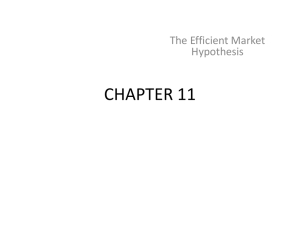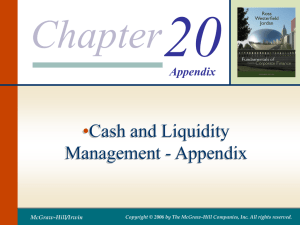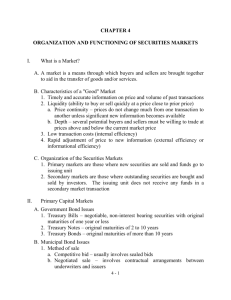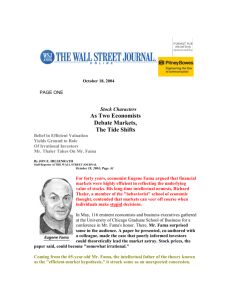MARKET EFFICIENCY
advertisement
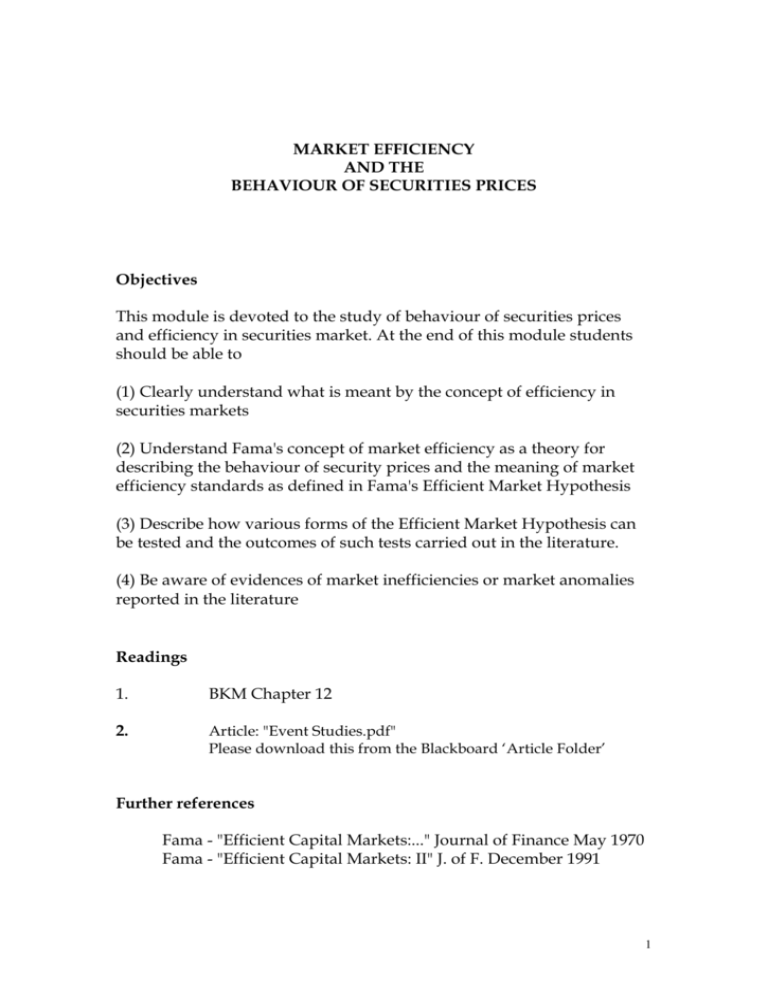
MARKET EFFICIENCY AND THE BEHAVIOUR OF SECURITIES PRICES Objectives This module is devoted to the study of behaviour of securities prices and efficiency in securities market. At the end of this module students should be able to (1) Clearly understand what is meant by the concept of efficiency in securities markets (2) Understand Fama's concept of market efficiency as a theory for describing the behaviour of security prices and the meaning of market efficiency standards as defined in Fama's Efficient Market Hypothesis (3) Describe how various forms of the Efficient Market Hypothesis can be tested and the outcomes of such tests carried out in the literature. (4) Be aware of evidences of market inefficiencies or market anomalies reported in the literature Readings 1. BKM Chapter 12 2. Article: "Event Studies.pdf" Please download this from the Blackboard ‘Article Folder’ Further references Fama - "Efficient Capital Markets:..." Journal of Finance May 1970 Fama - "Efficient Capital Markets: II" J. of F. December 1991 1 The topics examined in this module are organised as follows: 1. The concept of efficient capital markets 2. The Efficient Market Hypothesis 3. Implications for investors when markets are efficient: 4. Tests of market efficiency 5. Market anomalies or evidence of market inefficiencies 2 Efficiency of financial markets There are two dimensions to the meaning of efficiency in markets, which can be described as (1) Operational efficiency, and (2) Functional Efficiency or informational and valuation efficiency (1) Operational efficiency The key elements that make a market operationally efficient are market liquidity, orderliness and low costs of trading. Liquidity means investors can dispose of their holdings quickly and without sacrificing large price discounts from prevailing market prices. Factors that contribute to market liquidity are depth, breadth and resilience. Liquidity of the market is indicated by Breadth of market (trading volumes at prevailing prices) Depth of market (volumes of buy orders below and volumes of sell orders above the prevailing price) Market breadth and depth helps to ensure resilience. Market depth means the ability of the market to absorb temporary imbalances between securities supply and demand without leading to large price changes through the trading activities of market makers. Market makers must stand ready to buy up securities when the supply of securities exceed demand, or run down their inventories of securities when demand exceeds supply. Market breadth means trading volume and the existence of adequate competition among market makers to ensure that the spread between ask and bid price is small. Resilience means the ability of the market price to recover from unusually large sell or buy orders. Market orderliness is another important aspect of an operationally efficient market which is closely related to liquidity. In an orderly market price changes are smooth and not erratic. It is again competitive market making activity that ensures orderliness. Absence of price 3 manipulation is important to market orderliness. Price manipulation occurs when some participants have significant market power or when malpractices such as front running occurs. Low transaction costs provides a third contribution to operational efficiency. This means low taxes, brokerage commissions and bid-ask spreads. (2) Functional Efficiency Relates to Informational and valuation efficiency A market is informationally efficient if information that have a bearing on the value of securities are readily available to market participants. Informational efficiency leads to valuation efficiency. In a valuationally efficient market the prices of assets will be close to their intrinsic or fundamental values. Fama's formal definition of market efficiency - (JF 1970) A market is efficient relative to an information set if the price expectations formed on the basis of the information set is an unbiased predictor of the actual price subsequently realised. Let Pt t Et ( Pt 1 t ) t = price at time t = the information set available to investors at time t. = expectation of future price based on today's information set. = the deviation of the actual price from the expected price (the prediction error) this means t+1 = Pt +1 - Et ( Pt 1 t ) If the prediction error is unbiased then the market is efficient. Et(t+1) = 0 4 STANDARDS OF MARKET EFFICIENCY (The Efficient Market Hypothesis - Fama (1970) ) In order to estimate and also test the degree of efficiency of a particular market, we need to define standards of efficiency as a yardstick of measurement. Eugene Fama has defined three levels of market efficiency on the basis of the amount of information that is built into (or impounded in) market prices. all public all public and all publicinformation information historical private historical historical information information information information 1. Weak Form Efficiency Only historical information such as the history of past price patterns are reflected or built into the current market price. The implication is that investors cannot use any knowledge of past price trends or patterns to predict future price changes and thereby develop trading strategies to earn abnormal returns. 2. Semi strong Form Efficiency A higher level of efficiency than the WFE. Assumes that all currently publicly available information is already fully reflected in market prices. 5 The implication is that investors cannot use any publicly available information already known to the market to develop strategies to earn abnormal returns. 3. Strong Form Efficiency The highest possible level of efficiency. Assumes that all information, whether publicly or privately held, including those with corporate insiders or market specialists, are fully reflected in market prices. The implication is that even investors with insider information cannot use their information to earn abnormal returns. Some properties associated with an efficient market (i) Price changes will result only from new information that have an effect on present and future security returns rather than on existing information. (ii) Market prices will react to new information quickly and accurately (unbiasedly) (iii) Market prices will follow (or be close to) a random walk process. Pt = Pt-1 +d + t t is an independent and identically distributed (iid) series of random errors, d is the drift in price (iv) Market prices of securities will generally reflect their true intrinsic values. 6 Some factors driving markets to efficiency and why we can expect financial markets to be efficient (i) Laws that compel firms to disseminate important information quickly to the market (ii) An efficient and technologically advanced information network (iii) The strong competition among analysts and investors drives prices towards efficiency. Large numbers of investors all looking for abnormal profit opportunities, will by their own actions, compete away such opportunities. (iv) Investors and analysts are educated, knowledgeable and 'smart'. (v) The independence of the actions of investors. The law of large numbers will ensure that the net effect of uncorrelated trading actions of investors will result in the average prices being accurate. (vi) Do insider trading laws hinder market efficiency ? INSIDER TRADING AND THE LAW Amendments to the Corporations Law introduced in August 1991 Who is an insider ? An insider is one who possesses 'price sensitive information which is not generally available'. An insider need not be connected to the firm under reference. 7 What is insider trading ? Trading based on insider information or communicating insider information to another who might trade on that information is illegal. Implications for investors and the likely effectiveness of investment strategies if markets are truly efficient: (i) Predicting price changes based on historical information or past price patterns will be impossible. Therefore 'Technical' analysis based on analysing historical price patterns would be useless. Also 'market timing' strategies may be of little benefit (ii) Since market prices will adjust to new information very quickly and will accurately reflect fundamental values in general An active stock selection strategy based on fundamental stock analysis for identifying under and over priced stocks would not be easy. (a) Securities will plot on the security market line given that asset valuation theories such as the CAPM is correct. (b) Investors can only hope to earn a normal return from their investments. A normal return is the return commensurate to the level of risk in the investment according to the CAPM. (iii) Passive investment strategies such as investing in an index fund or other buy and hold strategies would be the most appropriate. Some alternative to the Efficient Market Hypothesis for describing the behaviour of the stock market 1. The Market Overreaction Hypothesis (or the winner-loser hypothesis) Debondt and Thaler (JF 1985) 8 A theory based on irrational investor behaviour. 2. The Rational Speculative Bubbles hypothesis Blanchard and Watson (1982) A theory based on rational investor behaviour which at the same time can lead to the deviation of market prices from their fundamental values. TESTING FOR MARKET EFFICIENCY (1) Tests of weak form market efficiency Can past returns be used to predict future returns ? (a) Testing for serial correlation T 1 1 1 rt r ) rt 1 r 2 Ex: first order autocorrelation 1 T 1 t 1 (b) Testing filter rules for stock trading (2) Tests of semi-strong form market efficiency (Event Studies): Testing how quickly and accurately security prices respond to newly released public information ? 9 Stock price over reaction efficient response delayed reaction Time (days) t-1 t t+1 Event study methodology A test of semi strong efficiency is whether the stock price reaction to an event, taking place on day t (such as a better than anticipated earnings announcement) brings forth an immediate price reaction or whether the response lags on to day t+1 and t+2 etc. Test procedure (1) Select a sample of firms making for example, better than anticipated earnings announcements. (2) Test their price responses on day t , t+1, ......(where t = announcement date) (3) But prices will change anyway due to overall market changes (with or without the announcement). (4) Need to isolate and examine price change solely due to the announcement effect. 10 Observed return (OR) = Return due to announcement (AR) + Normal return (NR) Normal return (or expected return) is the return based on the relation of the firm's return to that of the market and could be measured by applying the market model (characteristic line ). The normal return on day t for firm i based on the characteristic line is given by Rit = E(Rit) = AR ai + i Rmt + eit ai + i E(Rmt) = OR - NR = Rit - E(Rit) = Rit - [ai + i E(Rmt) ] = eit The abnormal returns are the regression residuals (5) Calculate the average abnormal returns (AAR) Average of the residuals for the particular day across all the sample firms (6) Calculate the cumulative average abnormal returns (CAAR) over a time interval. The sum of the average abnormal returns over several days t+1, t+2 ... etc. (7) Are the CAARs significantly different from zero ? Example: The CAAR pattern in an efficient market 11 Cum. abnormal return x x 0 x Time (days) t-1 t t+1 Example: In the study by Foster, Olsen and Shevlin : Stocks with large positive earnings surprises earned abnormal returns from up to 60 days prior to the earnings announcement and up to 60 days after the earnings announcement. What does this imply about market efficiency ? (3) Tests of strong form market efficiency (i) Testing whether abnormal profits are made by corporate insiders. Or test whether abnormal returns are made by outsiders following insiders' trading patterns. ie. the Jaffe study, Seyhun study (ii) Testing whether abnormal returns are made by NYSE specialists EMPIRICAL EVIDENCE OF MARKET INEFFICIENCIES OR MARKET ANOMALIES (1) Tests of market predictability (i) Predictability of short term returns 12 Overall, tests of serial correlation, runs tests and filter rules find that weak form efficiency is largely validated. (Fama 1965, Fama and Blume, Lo and MacKinlay etc.) (ii) Predictability of long horizon returns Fama and French 1988 and Poterba and Summers 1988 find negative correlation in long horizon returns. These results suggest mean reversion in stock prices. But does it necessarily invalidate market efficiency ? (iii) Predictors of aggregate stock market returns Fama and French 1989 and Campbell and Shiller 1988 find that variables such as dividend yield, default yield spread can predict variation in stock market returns. (2) Cross sectional anomalies Are the cross sectional anomalies the result of market inefficiency or the result of asset pricing anomalies ? (i) The Small firm effect (high returns of small firms especially in January) Banz 1981, Reinganum 1983 Keim 1983 (ii) The low P/E strategy (high returns of low P/E stocks) Basu 1977 (iii) The market to book value ratio Fama and French 1992 (iv) The neglected firm effect Arbel and Strebel 1983, Amihud and Mendelson 1986 13 (v) The Value Line stock ranking system Value Line claims that the performance of stocks over the next 12 month period can be predicted if stocks are ranked in accordance with the following criteria. The rank is based on a composite of (1) relative earnings momentum (2) Earnings surprise (3) Nonparametric value position (3) Seasonal Anomalies (i) The January effect (high returns in January) (ii) The weekend effect (never sell on Mondays) French (1980) 14
